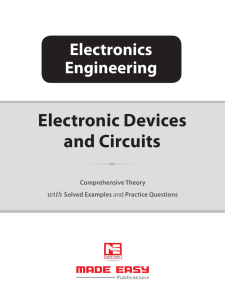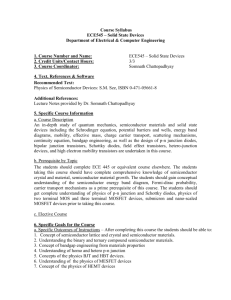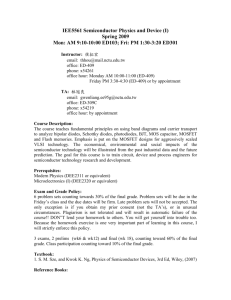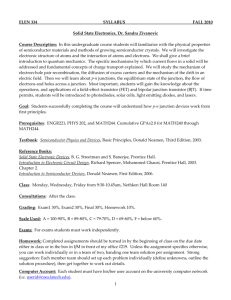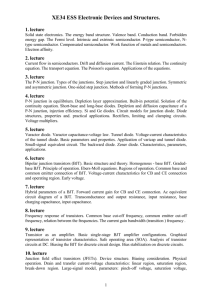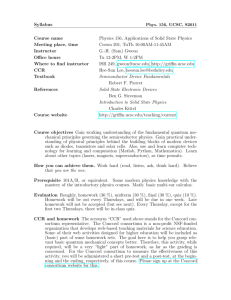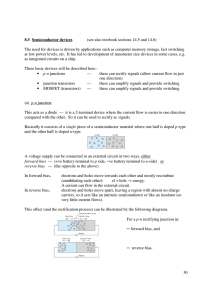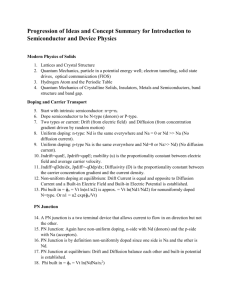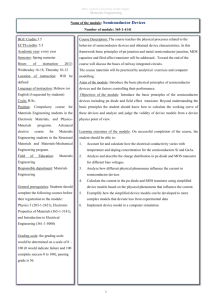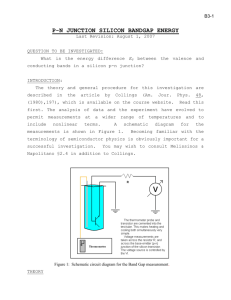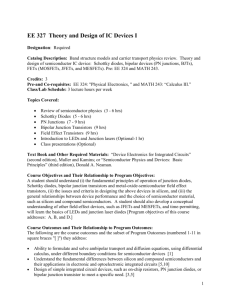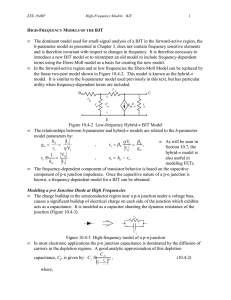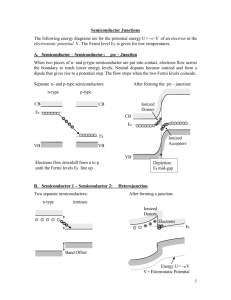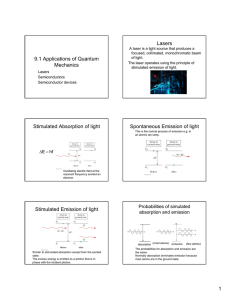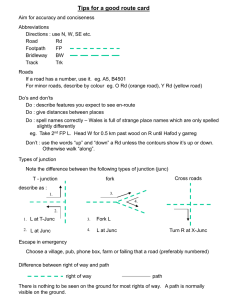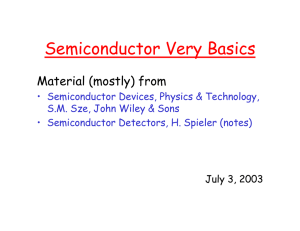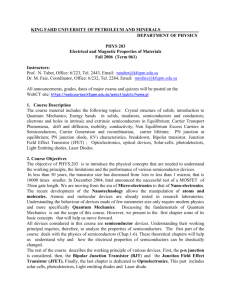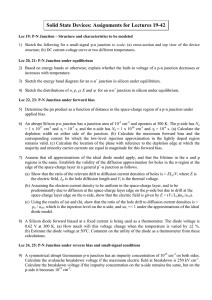ECE 445 ()
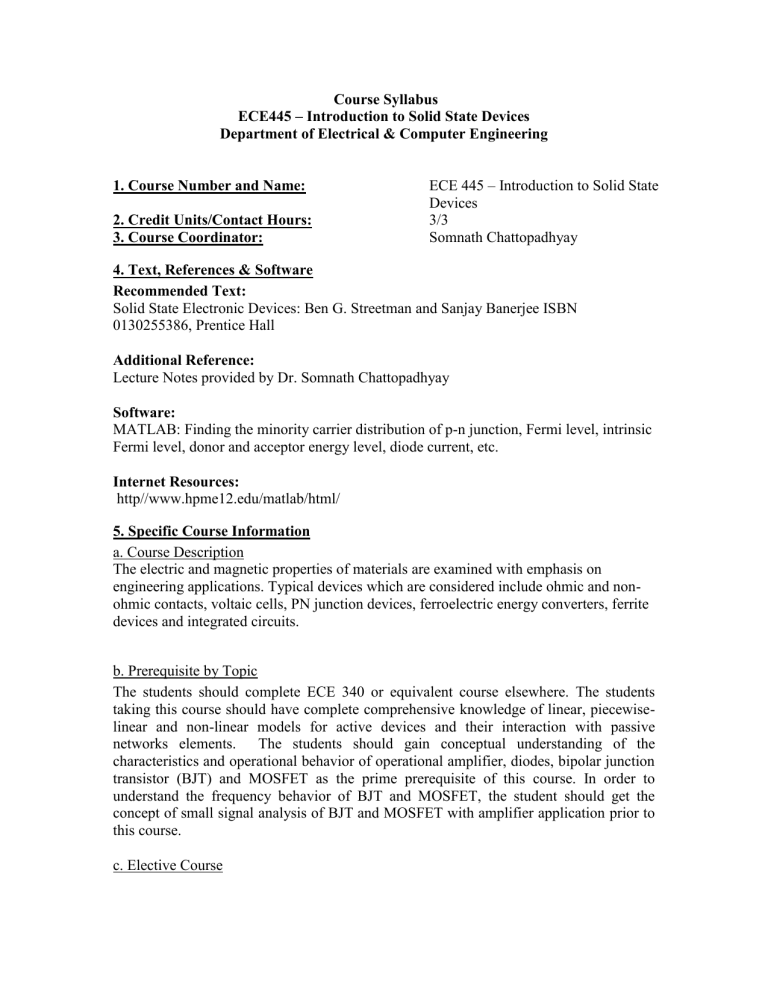
Course Syllabus
ECE445 – Introduction to Solid State Devices
Department of Electrical & Computer Engineering
1. Course Number and Name: ECE 445 – Introduction to Solid State
Devices
2. Credit Units/Contact Hours:
3. Course Coordinator:
3/3
Somnath Chattopadhyay
4. Text, References & Software
Recommended Text:
Solid State Electronic Devices: Ben G. Streetman and Sanjay Banerjee ISBN
0130255386, Prentice Hall
Additional Reference:
Lecture Notes provided by Dr. Somnath Chattopadhyay
Software:
MATLAB: Finding the minority carrier distribution of p-n junction, Fermi level, intrinsic
Fermi level, donor and acceptor energy level, diode current, etc.
Internet Resources:
http//www.hpme12.edu/matlab/html/
5. Specific Course Information a. Course Description
The electric and magnetic properties of materials are examined with emphasis on engineering applications. Typical devices which are considered include ohmic and nonohmic contacts, voltaic cells, PN junction devices, ferroelectric energy converters, ferrite devices and integrated circuits. b. Prerequisite by Topic
The students should complete ECE 340 or equivalent course elsewhere. The students taking this course should have complete comprehensive knowledge of linear, piecewiselinear and non-linear models for active devices and their interaction with passive networks elements. The students should gain conceptual understanding of the characteristics and operational behavior of operational amplifier, diodes, bipolar junction transistor (BJT) and MOSFET as the prime prerequisite of this course. In order to understand the frequency behavior of BJT and MOSFET, the student should get the concept of small signal analysis of BJT and MOSFET with amplifier application prior to this course. c. Elective Course
6. Specific Goals for the Course a. Specific Outcomes of Instructions – After completing this course the students should be able to:
1.
Understand concept of semiconductor lattice and crystal and semiconductor materials
2.
Understand the Fermi dirac probability, intrinsic and extrinsic semiconductors, semiconductor in equilibrium and non equilibrium.
3.
Understand concept of carrier transport Phenomena
4.
Understand some concepts of p-n junction fabrication and familiarity fabrication process and process tools.
5.
Understand of the physics of p-n junction and Schottky diodes
6.
Understand concept of fundamentals of MOS devices
7.
Understand the physics of MOSFET and submicron and nano-scaled MOSFET devices. b. Relationship to Student Outcomes
This supports the achievement of the following student outcomes: a.
An ability to apply knowledge of math, science, and engineering to the analysis of electrical and computer engineering problems. b. An ability to analyze and interpret experimental data, demonstrated by the use of appropriate mathematics, graphics, and/or numerical methods. e. An ability to identify, formulate, and solve electrical and computer engineering problems. i.
A recognition of the need for and an ability to engage in life-long learning. k. An ability to use modern engineering techniques for analysis and design. l. Knowledge of probability and statistics. n. Knowledge of math including differential equations, linear algebra, complex variables and discrete math.
7. Topics Covered/Course Outline
1.
Crystal Lattices and semiconductor Materials
2.
Intrinsic and Extrinsic semiconductors and Energy Bands
3.
Carrier Transport
4.
Semiconductor in equilibrium and non- equilibrium
5.
Physics of p-n junction I
6.
Fabrication of the PN Junction
7.
Physics of the PN Junction II
8.
Physics of Schottky junction
9.
Introduction of MOS Device
10.
Physics of Submicron and Nano-scaled MOSFET Devices
Prepared by:
Somnath Chattopadhyay, Professor of Electrical and Computer Engineering, November 2011
Ali Amini, Professor of Electrical and Computer Engineering, March 2013
